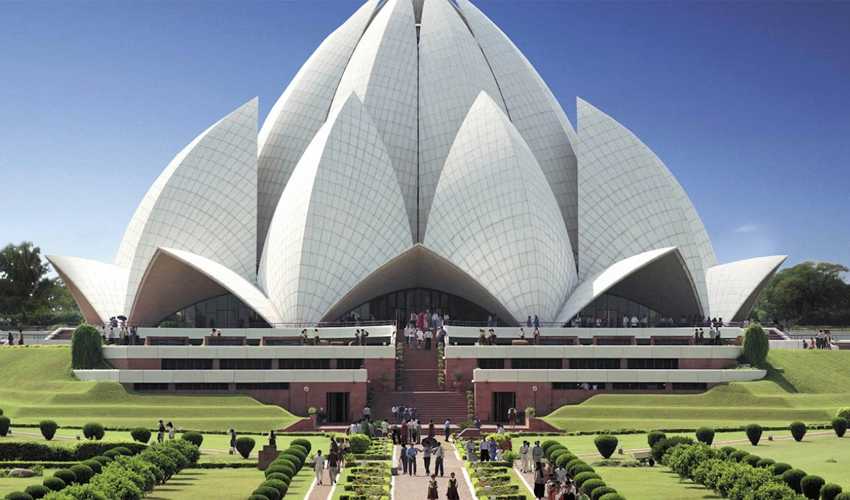The Lotus Temple in New Delhi is known as the Bahai Temple because it is one of the principal Baháʼí Houses of Worship globally, dedicated to the teachings and universal values of the Baháʼí Faith—an inclusive religion that embraces the unity of all religions.
Baháʼí Faith and the Concept of Unity
The Baháʼí Faith originated in the 19th century and centers around the essential unity of all people and religions, teaching that humanity is a single family and that all faiths are expressions of one divine truth. Baháʼí Houses of Worship exemplify these principles by being open to everyone, regardless of caste, creed, or religion. The Lotus Temple, like all Baháʼí Temples worldwide, was built without any idols, statues, or religious imagery, focusing entirely on silent prayer, meditation, and readings from holy scriptures of multiple faiths. This inclusivity and openness is why the Lotus Temple is also called the Baháʼí Temple—it is foremost a spiritual center for all, unattached to any single religious tradition.
Symbolic Architecture—Why Lotus?
The temple’s unique design, modeled after the lotus flower, carries deep symbolism in Indian culture. The lotus represents purity, peace, and spiritual awakening, making it a fitting emblem for a Baháʼí House of Worship meant to transcend sectarian boundaries. The architect, Fariborz Sahba, chose the lotus specifically to create a space that would resonate with Indians of all backgrounds and symbolize the hope for unity, harmony, and spiritual elevation.
The Lotus Temple’s structure features 27 marble “petals” clustered into groups of three to form nine sides, reflecting the mystical significance of the number nine in the Baháʼí Faith. Nine is regarded as the highest single-digit number and represents completeness and unity, further echoing Baháʼí ideals. The temple’s nine doors welcome visitors from all directions and backgrounds, leading to a central prayer hall that can accommodate up to 2,500 people—a space designed for collective reflection and peace.
Historical Context and Construction
Inaugurated in December 1986, the Lotus Temple was designed by Iranian architect Fariborz Sahba and built by ECC Construction Group of Larsen & Toubro Limited. Funds for its construction came from Baháʼí devotees, notably Ardishír Rustampúr of Hyderabad, Sindh, whose donation bought the land. The temple’s pristine white marble was sourced from Greece, and its distinctive design has won global architectural awards and acclaim, earning recognition as one of the most visited buildings in the world.
Religious and Social Significance
The Baháʼí Temple is not merely an architectural marvel but a living beacon of the Baháʼí message. Its mission goes beyond worship—it stands as a center for social unity and spiritual education. Multi-faith prayer services often include readings from the scriptures of Buddhism, Hinduism, Islam, Christianity, and other world religions, demonstrating the Baháʼí commitment to interfaith dialogue. There are no clergy, sermons, or rituals—only silent prayer and collective meditation, emphasizing equality and the universality of the divine.
Nestled within landscaped gardens and tranquil pools, the Lotus Temple offers a peaceful retreat from the city’s bustle, with its serene ambiance encouraging contemplation within the heart of New Delhi. The pools and gardens are also symbolic, combining elements of nature—light and water—with spiritual architecture that elevates the visitor’s experience.
The Lotus Temple as a Global Baháʼí Symbol
The Lotus Temple is one of only a handful of Baháʼí Houses of Worship around the world, with each temple reflecting local culture while adhering to the faith’s principles. While the Baháʼí House of Worship is universal in function, the Lotus Temple’s influence has been particularly significant for Indian society. Its open-door policy and spiritual message have made it a monument to pluralism and tolerance, attracting millions of visitors annually from India and abroad.
Conclusion
The Lotus Temple is called the Baháʼí Temple because it stands at the intersection of the Baháʼí spiritual mission and India’s rich cultural heritage. Through its lotus-inspired architecture, the temple expresses the Baháʼí message of unity, inclusivity, and peace. Its status as a Baháʼí House of Worship makes it a unique sacred space—open to all, without ritual or religious restriction—that welcomes humanity in its entirety to reflect, meditate, and find common spiritual ground.
